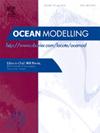Quantify the compound effects caused by the interactions between inland river system and coastal processes in hurricane coastal flooding through controlled hydrodynamic modeling experiments
IF 2.9
3区 地球科学
Q2 METEOROLOGY & ATMOSPHERIC SCIENCES
引用次数: 0
Abstract
Coastal flooding during hurricanes is a complex phenomenon involving the interaction of multiple drivers operating across different spatial scales, such as storm surge, rainfall, river discharge, and tides. Accurately assessing and predicting compound flooding requires considering the cross-scale nature of these processes and their interdependencies. This study investigates the compound effects and cross-scale interactions of flood drivers during Hurricane Matthew (2016) along the South Carolina coast using a coupled hydrology-hydrodynamic model. The model domain encompasses the land-ocean continuum, from rivers to the coastal ocean, allowing for the examination of compound flooding across the entire system. Controlled numerical experiments are conducted to quantify the individual, combined, and compound impacts of flood drivers across scales by selectively including or excluding riverine, storm surge, and tidal forcings. The coupled modeling approach reveals distinct zones of positive and negative compound effects, depending on the alignment of coastal water levels with river flood timing. River-surge interactions alter flooding, causing increases upstream and decreases downstream compared to isolated effects. Tide-surge and tide-river interactions induce oscillatory compound effects. The study demonstrates that the compound effect significantly influences hurricane coastal flooding beyond the linear superposition of flooding caused by individual drivers. The cross-scale modeling framework and analysis approach presented here can inform multi-hazard analysis, coastal flood risk management, and future studies of complex, multi-scale hydrologic systems.
通过控制水动力模拟实验,量化飓风海岸洪水中内陆河系与海岸过程相互作用的复合效应
飓风期间的沿海洪水是一个复杂的现象,涉及多个驱动因素在不同空间尺度上的相互作用,如风暴潮、降雨、河流流量和潮汐。准确地评估和预测复合驱需要考虑这些过程的跨尺度性质及其相互依赖性。本研究利用水文-水动力耦合模型研究了飓风马修(2016)期间南卡罗来纳海岸洪水驱动因素的复合效应和跨尺度相互作用。模型域包括陆地-海洋连续体,从河流到沿海海洋,允许检查整个系统的复合洪水。通过选择性地包括或排除河流、风暴潮和潮汐强迫,进行了控制数值实验,以量化洪水驱动因素在不同尺度上的单个、组合和复合影响。耦合模拟方法揭示了正、负复合效应的不同区域,这取决于沿海水位与河流洪水时间的排列。与孤立的影响相比,河流与涌浪的相互作用改变了洪水,导致上游增加,下游减少。潮-浪和潮-河相互作用引起振荡复合效应。研究表明,除了单个驱动因素引起的洪水线性叠加外,复合效应对飓风海岸洪水的影响显著。本文提出的跨尺度建模框架和分析方法可以为多灾害分析、沿海洪水风险管理以及未来复杂、多尺度水文系统的研究提供信息。
本文章由计算机程序翻译,如有差异,请以英文原文为准。
求助全文
约1分钟内获得全文
求助全文
来源期刊

Ocean Modelling
地学-海洋学
CiteScore
5.50
自引率
9.40%
发文量
86
审稿时长
19.6 weeks
期刊介绍:
The main objective of Ocean Modelling is to provide rapid communication between those interested in ocean modelling, whether through direct observation, or through analytical, numerical or laboratory models, and including interactions between physical and biogeochemical or biological phenomena. Because of the intimate links between ocean and atmosphere, involvement of scientists interested in influences of either medium on the other is welcome. The journal has a wide scope and includes ocean-atmosphere interaction in various forms as well as pure ocean results. In addition to primary peer-reviewed papers, the journal provides review papers, preliminary communications, and discussions.
 求助内容:
求助内容: 应助结果提醒方式:
应助结果提醒方式:


